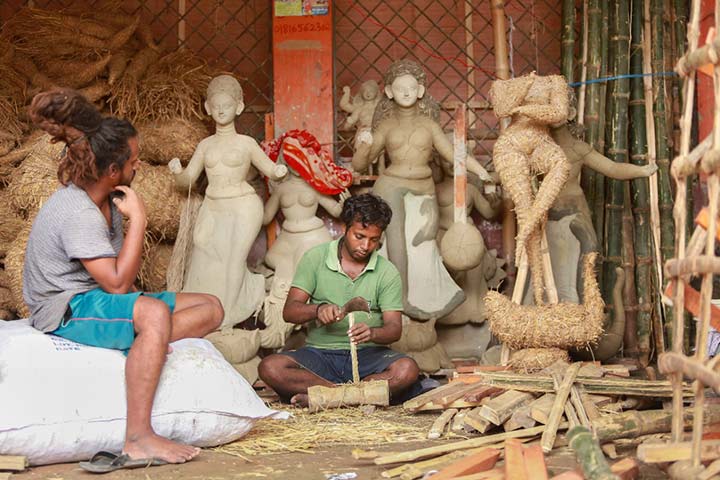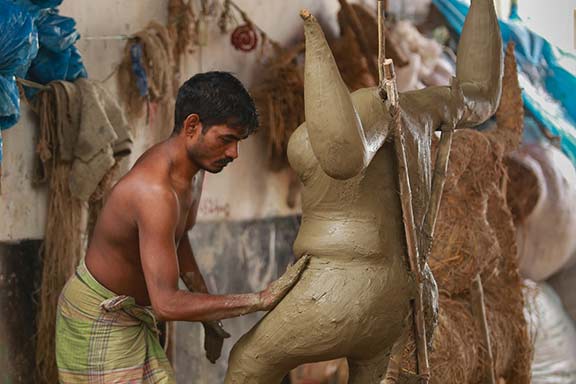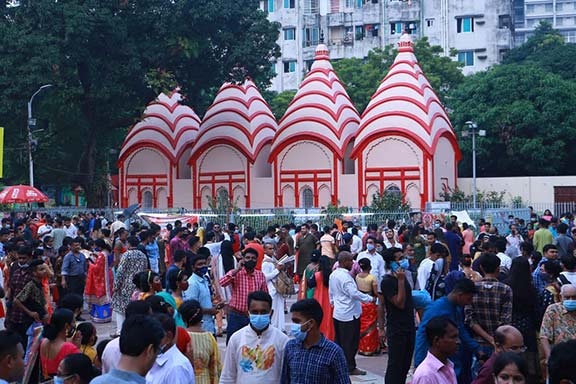Durga Puja is not the main religious festival for all Hindus. It is celebrated with the most formality and pomp among the Bengali-speaking Hindus of Bangladesh and West Bengal, India. It is also the largest religious festival in the Hindu-majority country of Nepal.
But how did Durga Puja become the main religious ritual of Bengali speaking Hindus?
Experts say that there is no mention of Durga Puja in the Ramayana written in Sanskrit. But when the Ramayana was translated into Bengali, the Mahatma of Durga as a goddess spread among the Bengali-speaking Hindus.
When Krittibas Ojha translated the Ramayana into Bengali six hundred years ago, he included in the folklore the story of Durga where it was prevalent. Then since the Bengali got the Ramayana in Bengali, and saw there that Ramachandra could kill Ravana with the help of Durga, then he would also come in handy for my daily needs.

In this way, Durga emerged as the chief goddess among the Bengali Hindus. But even then, Durga Puja took a few more years to become a major religious festival.
Durga Puja became popular mainly during British rule, under the patronage of Hindu elites and zamindars. There were many social problems with the class division among the Hindus. That is why Hinduism needed to be ‘modified’ then.
Then the elite class of Bengal saw the need for a force that everyone would accept. At that time worship of Durga became popular. There was a reason for this, the mother form of Durga. “

Another reason for the popularity of Durga Puja was the predominance of martial families in Bengal.
As a result, the Bengali Hindus quickly accepted it, and gradually the worship of Durga grew to surpass the worship of other gods and goddesses.
He added that there was an attempt to please the people among the local zamindars and traders due to its prevalence among the locals, which increased the level of pomp in Durga Puja.
Besides, there was a reason to choose autumn as the time of Durga Puja, as it was a somewhat regional puja, it does not rain much at that time.
Moreover, during the harvest season, when paddy and other crops were grown, the economic condition of the people was good. As a result, people could rejoice.

Duration of Durga Puja:
Shardiya Durga Puja is usually held from the sixth to the tenth day of the Shukla Paksha of the month of Ashwin. These five days are known as “Durgashti”, “Mahasaptami”, “Mahastami”, “Mahanabami” and “Vijayadashami” respectively. The white side of the month of Ashwin is called the “goddess side.” On this day, the new moon at the beginning of Devi Paksha is named Mahalaya. On this day, Hindus pay homage to their ancestors. The last day of Devipaksha is the Kojagari full moon. On this day, the Hindu goddess Lakshmi is worshipped. Somewhere, Durga Puja is celebrated for fifteen days. In that case, the puja starts on the ninth day before the mahalaya. This ritual is performed in the Mrinmayi temple in Bishnupur, West Bengal, and in many families. In West Bengal and Tripura, it is from Mahasaptami to Vijayadashami.
The ceremony of returning to the house of Goddess Durga’s father
Bengalis see this festival as a return to the home of the Himalayan goddess Durga. In Bengali society, it is customary to wear new clothes during this puja festival. It is also a special custom to visit the idol in the puja mandapa during the puja. In the Brahmavaivarta Purana, Krishna is said to be the promoter of Durga Puja. A list of how different deities performed Durga Puja is found in the Puranas. In the first age of creation, Paramatma Krishna worshipped the first Durga of Vrindavan, the origin of Vaikuntha. Then Brahma worshipped the second Durga for fear of two demons named Madhu and Katav. While fighting with a demon named Tripura, Shiva got in danger and organized the third Durga Puja.

The fourth puja that Indra performed after losing Lakshmi under the curse of Durbasa Muni was Durga Puja. Since then, sages, saints, gods, and people have been worshipping Durga in different countries at different times. According to Devi Bhagavata Purana, one of the main texts of Shakti Dharma, Manu, the son of Manas of Brahma, became the ruler of the world and worshipped Durga by making earthen idols of her on the shores of Kshirod Sagar. At that time, they began to chant Bagvat songs, gave up eating and breathing, stood on one leg and practised intense austerities for a hundred years. As a result, he was able to overcome the anger of cum even though Cumwas exhausted. Durganam became immobile under the influence of Samadhi while thinking. Then Durga was pleased and came to give him a gift. Manu then asked the gods for a rare gift. Durga defended that prayer. At the same time, Durga paved the way for her kingdom and gave Manu the gift of having a son.
Introduction of the first puja in Bengal
Raja Kangs Narayan of Tahirpur in Rajshahi district started the first puja in Bengal during the reign of Emperor Akbar (1556-1705). It is said in Mantantar that the first puja started in Nadia during the reign of King Krishna Chandra (1610-173). But Jimutbahan’s (approximately 1050-1150), Durgotsabanirnaya, Vidyapati’s (1364-1460) Durgabhaktitarangini, Shulapani’s (1385-1470) Durgotsabbibek, Krittibas Ojhar (approximately 1381-14) -16th century) Historiography Since all these texts contain detailed descriptions of Durga Puja, it is assumed that Durga Puja was prevalent in Bengal only in the tenth or eleventh century. Maybe from the time of Kangs Narayan or King Krishna Chandra, it started to be held in grand style.
In the nineteenth century, Durga Puja was performed in a grand procession in Calcutta. By the end of the eighteenth century, Europeans also took part in fortifications. Somewhere Jatragan, Pachali Kavigan used to be held. Baiji, dancers or singers used to take part in the houses of the rich.
Durga Puja in modern times
The earliest stages of Durga Puja in the modern era were in the 16th century when various musical instruments were used by the zamindars or royal staff. Watercolour photographs of the Durga Puja of 1809 have been found in Patna, Bihar. It is also believed that Durga Puja has been performed at the same place in Rameshwarpur, Orissa since the time of Emperor Akbar for 400 years. In 181, Bar Yaar or Barwari Puja was first organized by 12 friends of Gupta Para of Hughli. It was probably time, the time the Twelve Yari Puja started. In 1910, the Sanatan Dharmautsahini Sabha was held at Bhabanipur at Balaram Bose Ghatren, Ramadhanmitra Lane, Sikdar Bagan and Baroyari Puja was organized. Swami Vivekananda, an Indian philosopher and missionary, was the first to reintroduce the virgin puja at the Belur Math in Calcutta through the puja of nine virgins. In Hindu society, women were subjected to various injustices, including child marriage, satidah, eternal widowhood. Chir Kumar Swami Vivekananda introduced this puja to honour women as goddesses. However, virgin worship has been done in many places before. This puja has been going on every year since 1901, on the eighth day of Durga Puja. Spiritual and worldly welfare is the main goal of this Kumari Puja. Durga Puja is worshipped in the belief that the goal of human life is to get the grace of the mother by forgetting the dilemmas of the world and the difference between evil and evil. The idol of Goddess Durga that is commonly seen in Bengal is the idol of family harmony or family. At the centre of this idol are Goddess Durga Sinhabahini and Mahisasurmardini. On its crown is the small face of Shiva. On the right side of the goddess is the goddess Lakshmi, above and below Ganesha. On the left side is the goddess Saraswati, and below is Kartik. It is believed that the family of Sarban Roy Chowdhury of Calcutta introduced the puja of the Durga family in 1810. However, in some parts of Bengal, some structural differences can be observed in the position of the goddess of the Durga family, but the goddess Durga is worshipped with her family throughout Bengal.
In this context, Swami Prameyananda’s statement is memorable, he said, Dhandatri Lakshi, Vidyadayini Saraswati, Kartik, the symbol of valiant semen, Siddhidata Ganesha and their vehicles with all the idols of the majestic Durgamurti plan and worship is Bengal’s own.
Durgotsab is inextricably linked with Bengali culture. The belief that all the vehicles mentioned in the calendar at the time of arrival of Goddess Dharani and how Goddess Dharadham can actually take the natural weather in those vehicles has taken place in the minds of Bengalis.
Goddess Durga in the touch of pottery of Bengal
The idol of Goddess Durga that is commonly seen in Bengal is the idol of family harmony or family Durga. In the centre of this idol are Goddess Durga Sinhabahini and Mahisasurmardini; Shiva’s small face above his crown, Goddess Lakshmi on the right side of the goddess and Ganesha below; Goddess Saraswati at the top on the left and Kartikeya at the bottom. They gave the form of Kartikeya to the son of Zamindar, who was formerly the god of war in the form of Emperor Samudragupta. There is also a special idol of Goddess Durga in the Bishnupur-adjacent area of Bankura district. Ganesha and Lakshmi are on the right side of the Goddess, Kartikeya and Saraswati are on the left side above, and Shiva and the two companions of the goddess, Jaya and Vijaya, are on the two sides. In some houses in Kolkata, Lakshmi and Ganesha are seen exchanging places with Saraswati and Kartikeya during the Durgotsab. Again and again, Durga is seen sitting on Shiva’s lap. Apart from these, various unique idols of Goddess Durga are also seen in different parts of Bengal. However, no matter how varied the design or structure of Durga may be, Goddess Durga and her family are worshipped almost everywhere in the Durga festival in Bengal.
Rituals and ceremonies
The formality of Durga Puja originally started in the days of Mahalaya, or patriarchy. However, the significance of this day is basically different. This date is also called the patriarchy. On this day, the patriarchal party ends and the goddess party begins. On this Mahalaya Tithi, those who are fatherless remember their ancestors and offer offerings seeking the peace of their souls. According to the traditional religion, the dead souls are sent to Matya on this day. The gathering of the dead souls is called “mahalaya.” From mahalaya to mahalaya. This is also the last day of the patriarchy. In the Mahalaya, those who offer offerings in the Ganges for the peace of the souls of the East, offer prayers and offerings not only to the East but to the whole world. Those who do not have a son, those who do not have one, have to pay homage to those who are remembered today.
There is a story in the Mahabharata that: When the famous giver Karna dies and his soul ascends to heaven, he is given gold and gems as food. When Karna asked Indra the reason for this, Indra said that Karna had donated gold all his life and had never provided food for the purpose of his father. So in heaven, he was given gold as food. Korn said that since he was not aware of his fathers, he did not intentionally give gold to the fathers. For this reason, Karna was allowed to go to earth for sixteen days and provide food and water for his father. This party is known as the patriarchy. In some versions of this story, Yama is seen instead of Indra.
Durga Puja abroad
Durga Puja is celebrated in the Indian subcontinent and in many countries of the world including India, Bangladesh and Nepal. Durga Puja is celebrated with great pomp in the Indian states of West Bengal, Tripura, Assam, Bihar, Jharkhand, Manipur and Orissa. Even in 2006, local Bengali immigrants and museum authorities organized a huge Durga Puja as part of a cultural exhibition called “Voices of Bengal” season at the Great Hall of the British Museum in London, the capital of Great Britain.
At present, Duga Puja is celebrated in the Middle East, England, America, Australia and other countries.

